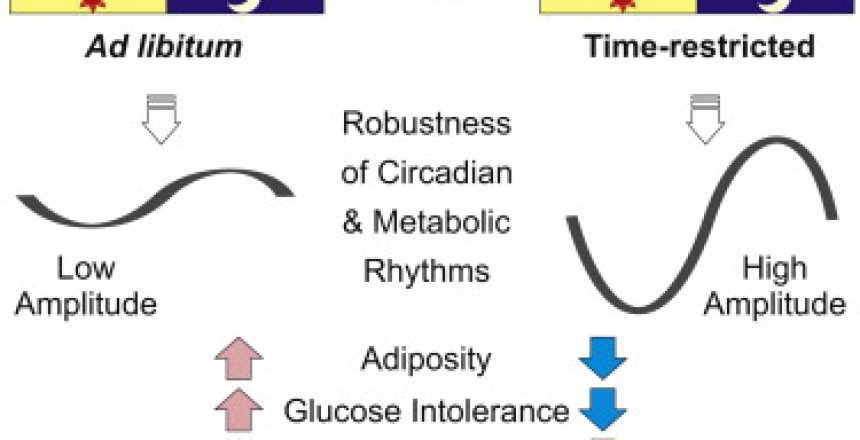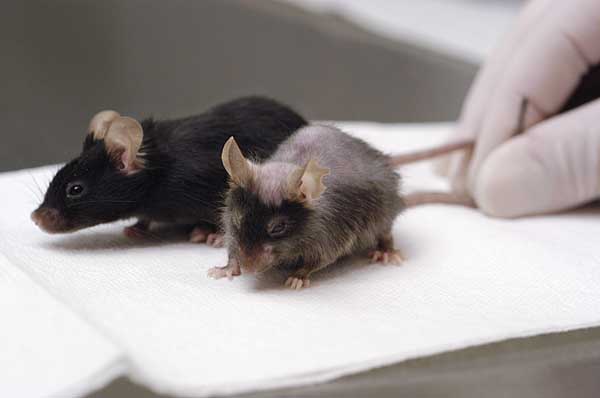The illustration is from Time-Restricted Feeding without Reducing Caloric Intake Prevents Metabolic Diseases in Mice Fed a High-Fat Diet.
While diet-induced obesity has been exclusively attributed to increased caloric intake from fat, animals fed a high-fat diet (HFD) ad libitum (ad lib) eat frequently throughout day and night, disrupting the normal feeding cycle. To test whether obesity and metabolic diseases result from HFD or disruption of metabolic cycles, we subjected mice to either ad lib or time-restricted feeding (tRF) of a HFD for 8 hr per day. Mice under tRF consume equivalent calories from HFD as those with ad lib access yet are protected against obesity, hyperinsulinemia, hepatic steatosis, and inflammation and have improved motor coordination. The tRF regimen improved CREB, mTOR, and AMPK pathway function and oscillations of the circadian clock and their target genes’ expression. These changes in catabolic and anabolic pathways altered liver metabolome and improved nutrient utilization and energy expenditure. We demonstrate in mice that tRF regimen is a nonpharmacological strategy against obesity and associated diseases.
These mice underwent a common form of intermittent fasting, namely a daily 8-hour feeding window followed by 16 hours of fasting. Despite eating the same amount of calories, they did not develop obesity, unlike the ad lib fed mice.
Ad lib eating could be a major cause of obesity in humans, in fact, the biggest cause. Before the obesity epidemic started, fast food was not as widely available, and certainly not 24 hours a day. People normally ate a regular dinner and then nothing until breakfast, resulting in a natural, daily cycle of 12 hours or so of intermittent fasting.
Along with low-fat diets, the modern paradigm also recommended frequent meals and snacking (“grazing”), which keeps insulin levels elevated and actually increases hunger. This was done on the dubious grounds of keeping blood sugar levels as some supposed optimum. Disastrous advice.
Perhaps the first thing to be done in obesity prevention, even before changes in type of food, is to limit eating to three (or fewer) meals a day. No snacking. To actually lose weight, intermittent fasting, such as the 16-8 schedule noted above, would be a good place to start.















9 Comments
Plus you get far more work done during the fasting period.
Yup. In fact, it’s better to work while fasting, then you don’t think about food.
Heschel Walker does the 23/1 schedule. Eats once a day at dinner- some bread, salad, soup, and on occasion chicken; heavy carbs, not much protein. Been doing it for years. And Walker is the best built 50 year old on the planet- not just ripped, but literally looks like a 25 year old NFL running-back, with no hint of aging. (Actually, that’s the most remarkable thing. Even muscular, low body fat 50 year olds show hints of age- you know it when you see it- Walker doesn’t.)
Anyway, yeah, Walker is a freak, but it’s hard to imagine he’s such a freak that he’d get such good results if the ideal diet was 3+ meals per day, + a few snacks. In other words, Walker’s existence makes more sense in a world where the 16/8 is ideal for most people.
So, eat big dinner and lunch, no snacks no breakfast,, lose weight?
I started intermittent fasting back in 2008, after reading Brad Pilon’s “Eat Stop Eat” e-book. For the first few years, I tried to maintain Pilon’s recommended regimen of only fasting 2-3 days/week, but out of basic laziness I now fast pretty much every work day, usually not eating at all until I get home in the afternoon–though I’ve recently started mixing 2 Tbsp of coconut oil with my coffee in the morning, so maybe it doesn’t count as fasting anymore! This works out to around 18-19 hours per day, five days a week. Weekends I eat more, but I still routinely go for long periods forgetting to eat.
In any event, IF has been great for me. I spent the first 40-odd years of my life depending on a very high-carb ad libitum diet, and I regularly experienced cravings and even occasional hypoglycemic attacks. When I hit my 30s, I pretty rapidly went from around 190 lb to a peak of 220 lb. I only managed to get control of things once I switched to low-carb with IF, and am now around 195 lb. Interestingly, I still have to watch for weight gain even on this restricted eating schedule, but I no longer experience cravings for high-carb foods, and hypoglycemia is pretty much a thing of the past. The biggest difference is the security of knowing that I’m in control of my appetite, and not the other way round. Most of the people I work with are still ruled by their cravings and can’t comprehend how I do it, but it takes no effort at all.
I’ve got a question I’m hoping someone can answer for me. I do IF, 8 hour eating period followed by 16 hour fasting period. I workout in the mornings on an empty stomach and have recently started taking bcaas during my workout because I wasn’t gaining much muscle and read that it helps. However after reading on this site that taking bcass while fasting negates any of the positive health benefits from autophagy I’m hesitant to continue taking them. If I don’t take bcass until I’m within my 8 hour eating window would it still negate the benefits of IF?
JT, as to your last question, BCAAs during feeding window are fine and do not negate IF anti-aging benefits. However, if you’re working out fasted, BCAAs are a good idea. You could skip the BCAAs for fasted w.o. if you eat immediately after w.o. What you don’t want to do is train fasted, no BCAAs, and then continue fasting.
Thanks mate, exact answer I was looking for, cheers